![]()
![]()
![]()
Use LEFT and RIGHT arrow keys to navigate between flashcards;
Use UP and DOWN arrow keys to flip the card;
H to show hint;
A reads text to speech;
60 Cards in this Set
- Front
- Back
|
How would you evaluate optic nerve function? |
By: • Appearance • Visual fields • Pupil reactions • Colour vision • Visual acuity • Diminished Light brightness sensitivity • Diminished contrast sensitivity |
|
|
What should you note about the physical appearance of the optic nerve head? |
– Colour – Shape – Size – Margins – Elevation – Additional features • Haemorrhages • Vascular changes |
|
|
How would you evaluate the function of the optic nerve- visual fields? |
Measured with full threshold automated perimetry –Humphrey 30-2 |
|
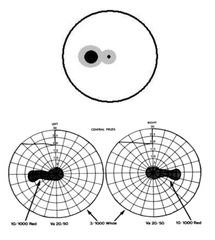
What kind of field defect is this? |
Centrocaecal – Central scotoma with enlarged blind spot |
|
|
What kind of field defect is this? |
– Altitudinal • Obeys horizontal mid-line affecting either inferior or superior field |
|
|
What would the swinging light test tell a out the optic nerve function? |
• Lesions of optic nerve head • Gross retinal lesions • Relative afferent pupil defect • Pupil reacts slower relative to the other
• If vision loss absolute -afferent pupillary defect present – Affected eye, when light shone in pupil will not constrict at all |
|
|
Name some acquired anomalies of the optic nerve. |
• Optic neuritis – Papillitis – Neouroretinitis – Retrobulbar neuritis
• Anterior ischaemic optic neuritis • Optic atrophy • Papilloedema |
|
|
What is Optic neuritis - Papillitis? |
• Inflammation of the optic nerve head
|
|
|
What would be seen with Optic neuritis - Papillitis? |
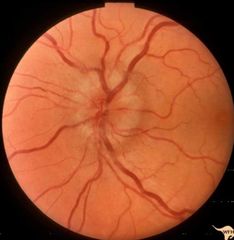
• Discs welling visible on ophthalmoscopy
• Variable disc hyperamia and oedema
• Cells in posterior vitreous |
|
|
In who is Optic neuritis - Papillitis more common in? |
Children- post viral |
|
|
What is Optic neuritis- Neouroretinitis? |
Papillits with inflammation of retinal nerve fibre layer
Least common
Usually self limitng |
|
|
What would be seen with Optic neuritis- Neouroretinitis? |
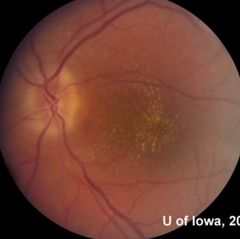
Macula star – Exudates |
|
|
What is Retrobulbar neuritis associated with? |
Usually with demyelinating diease MS |
|
|
What does Demyelinating Optic Neuritis present with? |
• Reduced VA • Reduced VF • Colour vision defects • RAPD • Pain on eye movements |
|
|
What is Optic neuritis by aetiology? |
• Demyelination • Parainfectious – Viral infection, immunization
• Infectious – Cat scratch fever, syphilis, AIDS, herpes zoster, meningitis • Non-infectious |
|
|
What is demeylination? |
• Destruction of insulating sheath on nerves • Disrupts conduction in nerves |
|
|
What is the commonest cause for demeylination? |
Multiple Sclerosis |
|
|
What is Multiple Sclerosis? |
– Idiopathic demyelinating disease – More common in women – Onset third to fourth decades – Relapsing remitting disease |
|
|
What are the ocular features Multiple Sclerosis? |
• Optic neuritis (retrobulbar) Internulear ophthalmoplegia
• nystagmus |
|
|
What are the symptoms of demyelinating optic neuritis? |
• Sub-acute unilateral visual loss
• Rarely bilateral • Discomfort on eye movements~90% • Tiny flashes of light? • Frontal headache, tenderness of the globe(rare) |
|
|
What will the visions be like with demyelinating optic neuritis? |
Reduced visual acuity • V/A 6/18 to 6/60 rarely worse • RAPD • Colour desaturation |
|
|
What would the disc look like with demyelinating optic neuritis? |
• Normal optic nerve head occasionally papillitis
• Possible temporal disc pallor |
|
|
What would the visual fields look like with demyelinating optic neuritis? |
– Reduction in sensitivity – Altitudinal defects – Arcuate – Or central/ centrocoaecal |
|
|
What is the optometric management for demyelinating optic neuritis? |
Refer urgently to neurologist (VF plots) |
|
|
What is the treatment for demyelinating optic neuritis? |
• Intravenous steroids • Immunodulatory treatment |
|
|
What is Anterior ischaemic optic neuritis AION? |
• Partial or total infarction of optic nerve head • Occlusion of short posterior ciliary arteries |
|
|
What are the 2 types of Anterior ischaemic optic neuritis? |
• Non-artertic • Arteritic |
|
|
Which type of Anterior ischaemic optic neuritis is more common? |
Non-artertic |
|
|
What are the predisposing factors to non-artertic AION? |
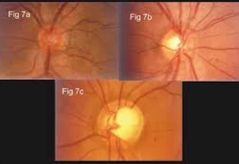
– Structural crowding of optic nerve head – Hypertension – Diabetes mellitus – Age> 50 years of age |
|
|
What are the symptoms of non-artertic AION? |
Sudden loss of vision often on waking |
|
|
What are the signs of non-artertic AION? |
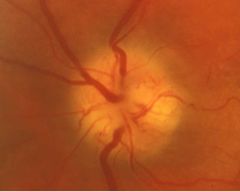
• VA normal or slightly reduced • VF defect– typically inferior altitudinal, central, paracental or arcuate defects
• Colour vision affected
• Diffuse or sectoral hyperaemic disc swelling • Few splinter haemorrhages |
|
|
What is the management for non-artertic AION? |
• Emergency referral to neurologist • Full vascular work up |
|
|
What is the treatment for non-artertic AION? |
• No definitive treatment • Treat any underling cause • Aspirin |
|
|
What is the prognosis of non-artertic AION? |
50% achieve 6/9 25% 6/60 or worse reoccurs- affects the other eye |
|
|
What is arteritic AION? |
Giant cell arteritis |
|
|
What are the symptoms of Giant cell arteritis? |

• Thickened tender superficial temporal arteries • Scalp tenderness –night and cold • Headache – normally constant • Local or generalised • Jaw .claudication |
|
|
What are the ocular symptoms of Giant cell arteritis? |
– Sudden profound loss of vision • May be preceded by amaurosis fugax – Unilateral – Periocular pain |
|
|
What are the signs of arteritic AION? |
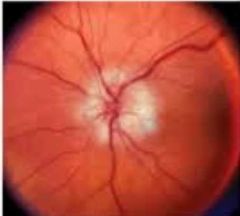
• Severe visual loss • Pale chalky white disc • Occasionally may be bilateral • Splinter haemorrhages • Over 1-2 months swelling resolves • Optic atrophy • Prognosis very poor |
|
|
What is the management for arteritic AION? |
Refer as an emergency |
|
|
What is Optic atrophy? |
• Late stage changes in optic nerve • Axonal degeneration between retina and LGN |
|
|
State the different types of optic atrophy. |
• Primary – Not associated with another disease • Secondary – Associated with another disease • Consecutive optic atrophy – Disease of the inner retina or blood supply • Glaucomatous optic atrophy |
|
|
What are the signs of Primary Optic Atrophy? |
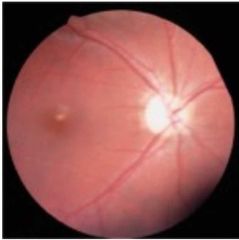
• Flat white disc • Margins clearly defined • Reduction innumber of bloodvessels on disc surface • Attenuation of peripapillary bloodvessels • Thinning of nerve fibre layer |
|
|
What are the causes of Primary Optic Atrophy? |
• Optic neuritis • Compression by tumours and aneurysms • Hereditary optic neuropathies • Toxic and nutritional • Trauma |
|
|
What are the ocular effects of optic atrophy? |
• Visual acuity is reduced, effects mild to severe
• Visual fields are affected
• Colour vision may be affected
• May be associated with nystagmus |
|
|
What is Secondary Optic Atrophy? |
Preceded by long-standing swelling of the optic nerve |
|
|
What would be seen with Secondary Optic Atrophy? |
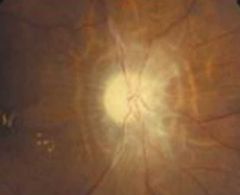
• Slightly raised greyish disc • Poorly defined margins – proliferation of glial cells • Reduction of number of blood vessels on disc surface • Retinochoroidal folds |
|
|
What are the causes of Secondary Optic Atrophy? |
– Chronic papilloedema – AION – Papillitis |
|
|
What is Consecutive Optic Atrophy? |
• Extensive retinal photocoagulatuion • Central retinal artery occulsion |
|
|
What would be at the disc with Consecutive Optic Atrophy? |
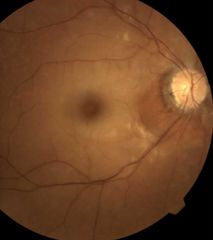
Waxy with well preserved blood vessels |
|
|
What is Papilloedema? |
Bilateral but often asymmetrical disc swelling due to raised intracranial pressure |
|
|
What are some of the other causes of papilloedema? |
– Idiopathic intracranial hypertension
– Intracranial haemorrhage
– Trauma |
|
|
What are the symptoms of Papilloedema? |
• Headache characteristics– worse after exercise, bending, head movement or coughing – may waken patient from sleep • Nausea, projectile vomiting
• Deterioration of consciousness |
|
|
What would be seen in early Papilloedema? |
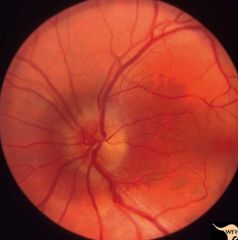
• Visual acuity normal • Dilated nerve fibres • Venous engorgement • Mild disc swelling and hyperaemia • Blurring of disc margins and peripaillary retinal nerve fibre layer • Loss of spontaneous venous pulsation |
|
|
What would be seen with established Papillioedema? |
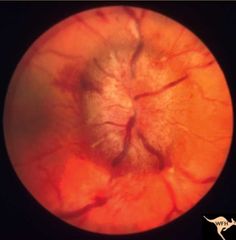
• Normal or reduced VA • Visual obscurations • Increased hyperaemia • Disc swelling no physiological cup • Venous engorgement • Cotton wool spots • Retinal folds • Hard exudates |
|
|
How would you manage Papillioedema? |
Refer as an emergency |
|
|
What percentage of the population have perceptible Anisocoaria? |
20% Asymmetry up to 2mm |
|
|
When is abnormally large pupils lesa noticeable? |
Under low lighting conditions |
|
|
What are the ocular effects of Adie's Pupil? |
Dilated pupil with weak or absent response to light
• Most have accommodative involvement initially • Light near dissociation • Risk of amblyopia |
|
|
When is abnormally small pupils lesa noticeable? |
Under low lighting conditions as the normal pupil dilates |
|
|
What are the ocular signs of Horner's syndrome? |
• Usually unilateral • Ptosis <2mm & lower lid elevation • Miosis • Anhidrosis
• Congenital Horners – Heterochromairidis
• Normal light and near reflex – Slow re-dilation
• Conjunctival vasodilation • May be increased accommodation |

